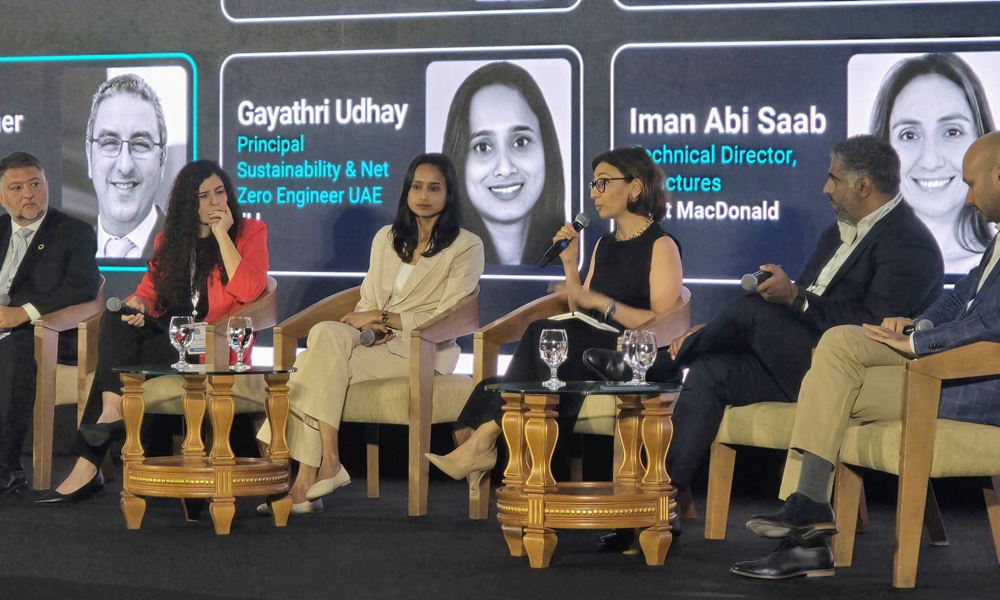Should the construction industry in the Middle East consider sustainable alternatives to its preferred concrete and steel mixture when it comes to building?
At the Energy and Water Summit hosted by Big Project Middle East magazine in Dubai, industry experts discussed the urgent need for sustainable alternatives to traditional concrete and steel in construction, highlighting the viability and challenges of these new materials in the region.
Iman Abi Saab, Technical Director for Structure at Mott Macdonald, emphasised the urgency of addressing cement-related emissions during today’s EWSSummit2025, noting that cement production alone contributes significantly to global emissions. “Cement is contributing a lot, around 8% of global emissions,” Abi Saab explained. “Most of the carbon comes from the kiln operation, thermal energy, and the chemical decomposition of materials within the kiln. We are still heavily reliant on carbon capture to control emissions from cement manufacturing.”
Abi Saab detailed several solutions currently accessible in the market, ranging from simple to complex.
“One easy method is specifying the maximum cement content in concrete mixes. Another common practice is cement replacement, where portions of cement are substituted with fly ash, micro silica, or slag,” she said. However, she cautioned that such replacements are also derived from energy-intensive processes, thus not entirely ideal.
Highlighting more advanced solutions, Abi Saab discussed geopolymer concrete, a promising alternative proven to substantially reduce carbon emissions. “Geopolymer concrete uses fly ash, slag, with an alkali activator; significantly cutting carbon emissions compared to traditional cement, while enhancing durability especially in marine environments,” she noted.
She also spotlighted innovative carbon capture methods like the carbon cure technology, which injects captured carbon back into fresh concrete, effectively reducing emissions. Looking further ahead, Abi Saab mentioned ongoing research into entirely new cement substitutes , though these are not yet commercially widespread.
Regarding aggregates, Abi Saab shared positive experiences from the UAE, saying, “We are successfully using recycled aggregates from construction waste, significantly reducing environmental impacts and supporting the circular economy.”
Turning to steel, Abi Saab emphasized the benefits of recycled steel, noting remarkable progress in the region.
“Companies in the UAE are already manufacturing steel using nearly 100% recycled content. Additionally, the advent of green steel, using green hydrogen instead of natural gas in manufacturing processes, presents substantial carbon reduction opportunities,” she added. “Combining recycled content with green steel processes could potentially reduce carbon emissions by 85% to 90%.”
Engi Jaber, Associate Partner for Sustainability and Head of Climatize, expanded on Abi Saab’s points, underlining the importance of considering sustainability holistically.
“While cement and steel remain primary concerns, other high-impact materials, like aluminum used for cladding, also need attention,” Jaber stated. She noted that aluminum typically has higher embodied carbon content compared to steel but emphasized that recycling aluminum significantly reduces this footprint.
Jaber advocated for a comprehensive evaluation of sustainable options, considering embodied energy alongside direct carbon savings. “A local supplier explained to me recently that producing recycled materials was often costlier and more energy-intensive than virgin materials,” she revealed.
“Sometimes, creating a low-carbon product paradoxically increases embodied energy by 20% to 30%, potentially offsetting direct carbon savings.”
Highlighting the complexities in choosing sustainable materials, Jaber pointed out, “We often fail to explore various options thoroughly. For instance, choosing between 3D printing construction methods and traditional cement and recycled steel combinations requires careful assessment, as the sustainability advantages are highly dependent on specific project parameters.”
Both experts agreed on the importance of a balanced approach, advocating for rigorous analysis to identify the most sustainable materials tailored to specific project requirements. This nuanced perspective stresses that while promising alternatives exist, achieving genuine sustainability in construction demands comprehensive assessments beyond immediate carbon reductions.
Engi Jaber said that the construction industry needs to be aware that energy use can go up by at least 20% to 30% to produce a no carbon product. The ideal greener approach can vary from one project to another.
“Which kind of conflicts with what we’re trying to do,” she said. “We (sometimes) fail to explore the different options and weigh the up properly. Do I go with a 3D printing construction method? Or do I go with a pre-fabricated cement and recycled steel method? Just going with your typical prefabricated-cement and recycled steel could actually be more eco-friendly than if we went with over-the-counter green cement. Or vice versa.”
